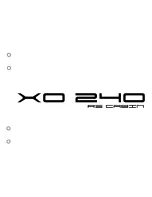
Cobalt_OM_preprint_shell.fm Page 2 Wednesday, March 1, 2006 5:39 AM
2
-
4
296 Owner’s Manual
COBALT
296
BOWRIDER
S
ECTION
2
Electrical Systems
Your Cobalt boat can be equipped with one or two
electrical systems. A direct current (DC) system is
battery powered and supplies electricity to lights,
pumps, blowers, engine ignition and sometimes a
refrigerator. An alternating current (AC) system is
shore power, or generator, and supplies electricity
to the electrical outlet, air conditioning, battery
charger and other 110V AC or 220V AC appliances
or components.
Cooling System
The engines and generator, if equipped, are cooled
by the continuous intake of raw water through
independent water intakes. The water flows to
water pumps on the engines and/or generator for
circulation around internal components. The engine
water intakes and outlets are located in the drive
units. A generator water intake is in the bottom of
the hull and the exhaust is usually on the side of the
boat, above the waterline. If your boat is equipped
with an air conditioner, the air conditioner water
intake is in the bottom of the hull and exits from the
side. Your Cobalt boat may be equipped with a
self-contained cooling system that pumps a mixture
of fresh water and antifreeze through a large heat
exchanger to reduce temperatures. Raw water is
circulated through the other side of the heat
exchanger to dissipate heat absorbed by the
coolant mixture.
Exhaust System
The engine and generator exhaust systems, if
equipped, remove the gases produced by the
running engine and vents them away from the boat.
Engine exhaust is usually vented through the drive
unit propeller but may be diverted through the
transom with the optional captain’s call exhaust
system. Engine and generator cooling water are
also removed along with the exhaust gases.
Lubrication System
The engines and generator, if equipped, use a
pressurized continuous loop lubrication system that
must be periodically serviced in accordance with
the manufacturer’s recommendations. The engines
have electrical transducer units to provide oil
pressure signals to gauges at the helm. Full oil
pressure must be available for proper lubrication,
so monitoring the gauges is important, especially
when operating at cruising speeds and above.
Seaworthiness Inspection
The following checks are essential to safe boating
and must be performed before starting the engines.
Get into the habit of performing these checks in the
same order each time so that it becomes routine.
• Check the weather report, wind and water
conditions.
• Check that required safety equipment is
onboard.
• Check that fire extinguisher(s) is fully charged.
• Check that bilge drain plug is properly installed.
• Check that no fuel, oil or water is leaking or has
leaked into the bilge compartment.
• Check all hoses and connections for leakage
and damage.
• Check that all batteries are fully charged and
have the proper level.
• Check electrical circuits (lights, pumps, horn,
etc.) for proper operation.
• Check that steering system operates properly.
• Be sure the boat is not overloaded.
• Check that all maintenance has been
performed.
Operation Checklist
While operating your boat, frequently check that the
control and steering systems continue to operate
smoothly. Monitor your gauges for signs of
abnormal behavior. Beware of any excessive
vibration. Refer to
Section 3
,
Before Starting
Checklist
.
Summary of Contents for 296 BOWRIDER
Page 6: ...vi 296 Owner s Manual COBAL T 296 BOWRIDER NOTES ...
Page 26: ...1 20 296 Owner s Manual COBAL T 296 BOWRIDER SECTION 1 NOTES ...
Page 96: ...3 42 296 Owner s Manual COBAL T 296 BOWRIDER SECTION 3 NOTES ...
Page 99: ...296 Owner s Manual 4 3 SYSTEMS FUEL ROUTING COB_0289_A FUEL FILL FUEL VENTS FUEL TANK ENGINE ...
Page 124: ...6 10 296 Owner s Manual COBAL T 296 BOWRIDER SECTION 6 NOTES ...
Page 132: ...7 8 296 Owner s Manual COBAL T 296 BOWRIDER SECTION 7 NOTES ...
















































